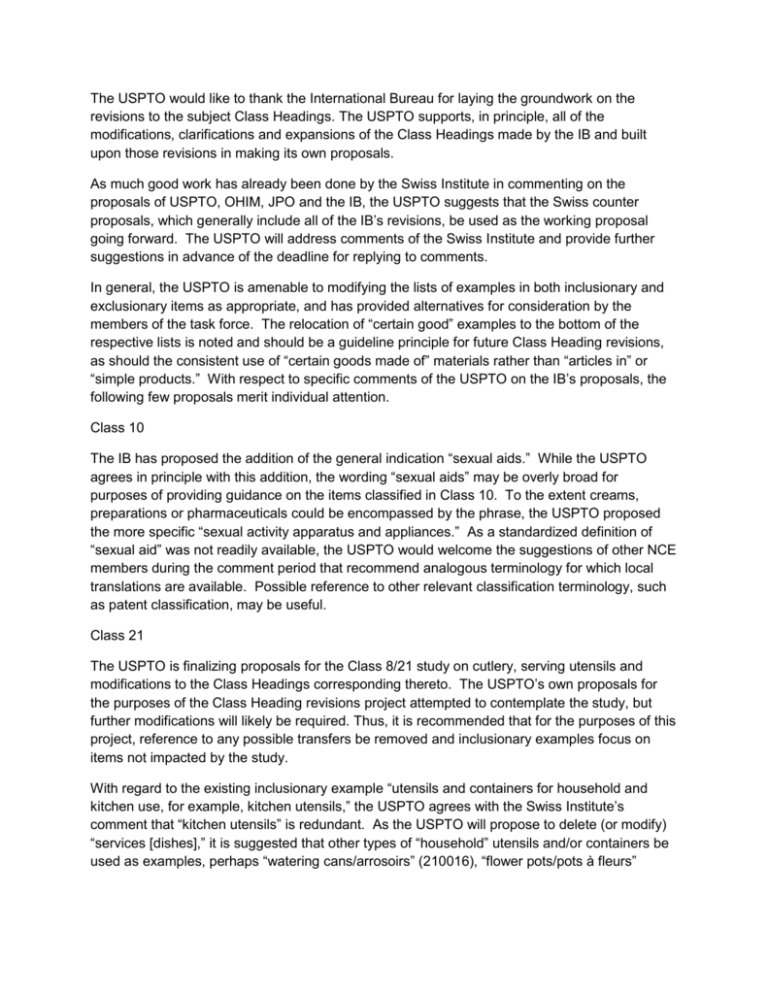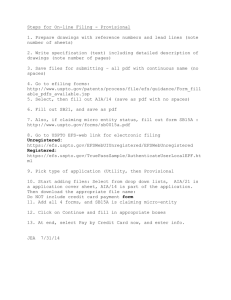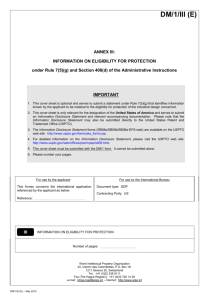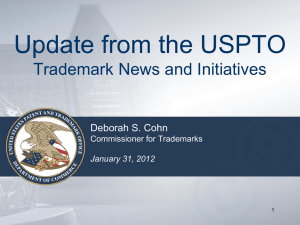
The USPTO would like to thank the International Bureau for laying the groundwork on the
revisions to the subject Class Headings. The USPTO supports, in principle, all of the
modifications, clarifications and expansions of the Class Headings made by the IB and built
upon those revisions in making its own proposals.
As much good work has already been done by the Swiss Institute in commenting on the
proposals of USPTO, OHIM, JPO and the IB, the USPTO suggests that the Swiss counter
proposals, which generally include all of the IB’s revisions, be used as the working proposal
going forward. The USPTO will address comments of the Swiss Institute and provide further
suggestions in advance of the deadline for replying to comments.
In general, the USPTO is amenable to modifying the lists of examples in both inclusionary and
exclusionary items as appropriate, and has provided alternatives for consideration by the
members of the task force. The relocation of “certain good” examples to the bottom of the
respective lists is noted and should be a guideline principle for future Class Heading revisions,
as should the consistent use of “certain goods made of” materials rather than “articles in” or
“simple products.” With respect to specific comments of the USPTO on the IB’s proposals, the
following few proposals merit individual attention.
Class 10
The IB has proposed the addition of the general indication “sexual aids.” While the USPTO
agrees in principle with this addition, the wording “sexual aids” may be overly broad for
purposes of providing guidance on the items classified in Class 10. To the extent creams,
preparations or pharmaceuticals could be encompassed by the phrase, the USPTO proposed
the more specific “sexual activity apparatus and appliances.” As a standardized definition of
“sexual aid” was not readily available, the USPTO would welcome the suggestions of other NCE
members during the comment period that recommend analogous terminology for which local
translations are available. Possible reference to other relevant classification terminology, such
as patent classification, may be useful.
Class 21
The USPTO is finalizing proposals for the Class 8/21 study on cutlery, serving utensils and
modifications to the Class Headings corresponding thereto. The USPTO’s own proposals for
the purposes of the Class Heading revisions project attempted to contemplate the study, but
further modifications will likely be required. Thus, it is recommended that for the purposes of this
project, reference to any possible transfers be removed and inclusionary examples focus on
items not impacted by the study.
With regard to the existing inclusionary example “utensils and containers for household and
kitchen use, for example, kitchen utensils,” the USPTO agrees with the Swiss Institute’s
comment that “kitchen utensils” is redundant. As the USPTO will propose to delete (or modify)
“services [dishes],” it is suggested that other types of “household” utensils and/or containers be
used as examples, perhaps “watering cans/arrosoirs” (210016), “flower pots/pots à fleurs”
(210133) or “shoe horns/chausse-pieds/cornes à chaussures/cornes à souliers” (210213). The
variety of goods in Class 21 should be represented in whatever examples are set forth.
Class 28
The use of the term “articles” in the general indication “gymnastic and sporting articles” is a
continued source of inconsistency for the USPTO. The broad meaning of the chosen term
“articles” was likely intended so as to cover a variety of objects or items that are not themselves
“apparatus” or “implements,” but are covered within the class. As noted by the Swiss Institute,
“balls for sport” would not be encompassed by “apparatus for playing sports” as proposed by
USPTO. Nevertheless, due to the wide variety of items that many consider to be “sporting
articles” but are otherwise classified in other classes based on a function that supersedes its
use for sporting or athletic purposes renders this indication and the reciprocal exclusionary
examples of great importance.
If, for purposes of classification, an object’s use by an athlete as a “sporting article” is
superseded by the function the object performs, further elaboration of this principle should be
made in the introductory sentence in order to avoid confusion by users. For example, as
“protective helmets for sports” (090656), “goggles for sports” (090654), and “hunting firearms”
(130026) clearly demonstrate this principle, an introductory statement to the effect that “goods
performing functions or purposes specifically mentioned in another class heading are classified
in that class when the same type of good can be used for a non-sporting purpose,” along with
these illustrative exclusionary examples following “certain sporting goods classified according to
their function or purpose as mentioned in other class headings, for example.”
Generally speaking, when significant exceptions exist to the scope of goods encompassed by
any general indication, especially those identifying a use, function or purpose rather than
material composition, an explanation as to principles controlling such exceptions is warranted
within the Class Headings themselves. For example, “Brushes, except paintbrushes” attempts
to carve an exception for one category of brushes, but multiple exceptions to this general
indication exist, e.g. “dynamo brushes” (070033), “brushes for cleaning body cavities” (100178),
“cleaning brushes for firearms” (130010) and “writing brushes” (160342). The NicePub
Information File for “brushes*” (210014) indicates “The brushes included in Class 21 are for
personal care or for domestic cleaning purposes.” While the Information Files are extremely
helpful, any justifying principles expounded therein are most likely worthy of inclusion in the
Explanatory Notes.












